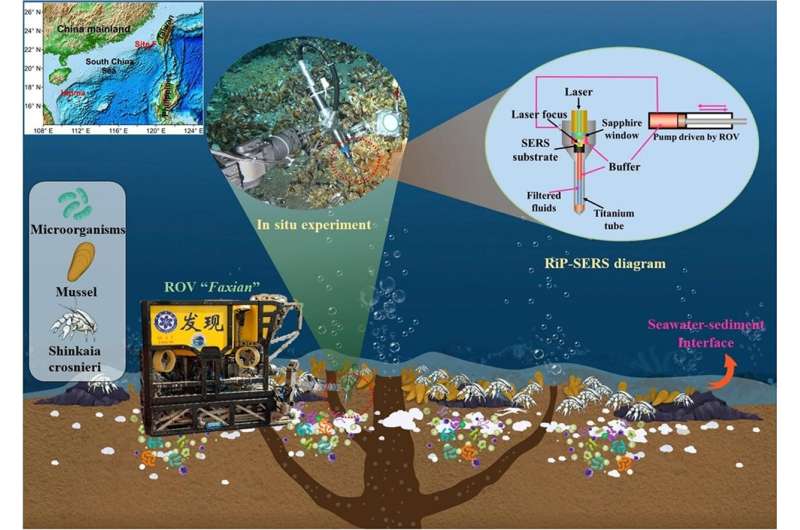Graphical abstract. Conceptual diagram of the in-situ SERS detection of the microbial community in deep-sea cold seep vents: Conceptual design of RiP-SERS on the right side of the panel; photo of in situ detection of RiP-SERS on left side of panel. Credit: Applied Surface Science (2023). DOI: 10.1016/j.apsusc.2023.156854
The phenomenon of chemically synthesized life in extreme deep-sea environment is an international research hotspot in deep-sea science and life science. However, due to the extremely low concentration of organic macromolecules such as extracellular metabolites synthesized by deep-sea chemicals and the complex surrounding environment, there is no in-situ detection technology so far.
Recently, a research team led by Prof. Zhang Xin from the Institute of Oceanology of the Chinese Academy of Sciences (IOCAS), with researchers from the Institute of Physics, has developed a new type of Raman scattering insertion probe (RiP-SERS) to detect deep sea biological macromolecules.
The probe was based on the early developed nanomaterial, which breaks through the Surface Enhanced Raman spectroscopy (SERS) detection technology in the deep-sea environment resistant to high pressure, low temperature, high salt and turbid fluid.
The study was published in Applied Surface Science.
The researchers designed this new type of RiP-SERS and adjusted the SERS substrate at the Raman laser-focusing position (the distance was 3 ± 0.5 mm). At the cold seep vents of the Formosa Ridge in the South China Sea, they used ROV Faxian equipped with RiP-SERS system to achieve pressure resistance test for the SERS substrate.
What's more, they used RiP-SERS to obtain Raman spectral data of bioinformation molecules in the seawater-sediment interface of Haima cold seep vents, and found that the marine-biome interface was rich in acetyl-CoA, β-carotene, and four amino acids. The success of this experiment adds a new method for future deep-sea biomolecular detection.
"The SERS substrate can be used for macromolecule detection in complex industrial systems because it can withstand a complex deep-sea cold-seep environment (pressure, salinity, pH, and metal-salt presence)," said Wang Siyu, first author of the study.
"This is another breakthrough after the team developed RiP-Cs, RiP-Pw, RiP-Hv and RiP-Gh probes," said Prof. Zhang, corresponding author of the study.
More information: Siyu Wang et al, In situ surface-enhanced Raman scattering detection of biomolecules in the deep ocean, Applied Surface Science (2023). DOI: 10.1016/j.apsusc.2023.156854
Provided by Chinese Academy of Sciences
























